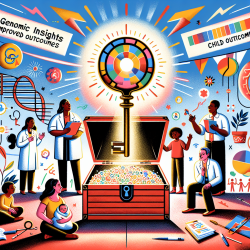As practitioners dedicated to improving the lives of children with hearing loss, we constantly seek innovative solutions that can make a tangible difference. One such innovation is Nonlinear Frequency Compression (NFC), a technology that has shown promise in enhancing speech recognition and detection abilities in children and adults with high-frequency hearing loss. This blog post delves into the findings of the research article "Evaluation of nonlinear frequency compression: Clinical outcomes" and offers actionable insights for practitioners looking to implement NFC in their practice.
Understanding Nonlinear Frequency Compression
Nonlinear Frequency Compression (NFC) is a hearing aid technology designed to improve the audibility of high-frequency sounds by compressing them into a lower frequency range. This is particularly beneficial for individuals with high-frequency hearing loss, as it enhances their ability to detect and recognize speech sounds that are otherwise inaudible.
Key Findings from the Research
The study evaluated the clinical outcomes of NFC processing on 24 participants, including 13 adults and 11 children with high-frequency hearing loss. The key findings were:
- Significant improvement in consonant and plural recognition when NFC was enabled.
- No significant change in vowel recognition.
- Greater benefit observed in children compared to adults.
- Variability in individual outcomes related to factors such as the degree and configuration of hearing loss, age, and type of outcome measure.
Implementing NFC in Clinical Practice
For practitioners, the findings suggest several actionable steps to improve outcomes for children with hearing loss:
- Customized Fitting: Ensure that NFC settings are customized based on individual hearing profiles, particularly focusing on the degree and configuration of high-frequency hearing loss.
- Age-Specific Approaches: Recognize that children may derive more benefit from NFC compared to adults. Tailor your fitting and follow-up protocols accordingly.
- Monitor and Adjust: Regularly monitor the child's progress and be prepared to adjust NFC settings to optimize speech recognition and detection.
- Educate and Involve Caregivers: Educate parents and caregivers about the benefits of NFC and involve them in the monitoring process to ensure consistent and effective use of the technology.
Encouraging Further Research
While the study provides promising results, it also highlights the need for further research to better understand the variability in individual outcomes. Practitioners are encouraged to contribute to ongoing research efforts by documenting and sharing their clinical experiences with NFC.
To read the original research paper, please follow this link: Evaluation of nonlinear frequency compression: Clinical outcomes
Conclusion
Nonlinear Frequency Compression offers a promising avenue for improving speech recognition and detection in children with high-frequency hearing loss. By implementing the insights from this research, practitioners can make data-driven decisions that lead to better outcomes for their young patients.










